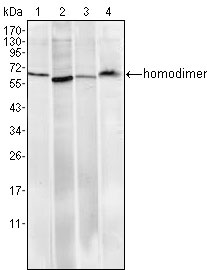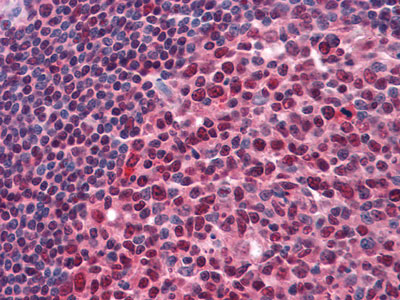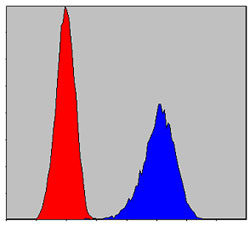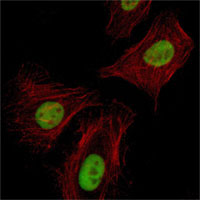Pirh2 Antibody
Purified Mouse Monoclonal Antibody
- SPECIFICATION
- CITATIONS
- PROTOCOLS
- BACKGROUND

Application
| WB, IHC, FC, ICC, E |
|---|---|
| Primary Accession | Q96PM5 |
| Reactivity | Human, Rat |
| Host | Mouse |
| Clonality | Monoclonal |
| Clone Names | 1H10 |
| Isotype | IgG1 |
| Calculated MW | 30kDa; 60kDa (homodimer) |
| Description | Pirh 2 (P53 induced RING-H2 protein), also known as RCHY1, it forms dimers through its N- and C-terminus in cells. The Pirh2 has ubiquitin-protein ligase activity and it binds with p53 and promotes the ubiquitin-mediated proteosomal degradation of p53. The Pirh2 is oncogenic because loss of p53 function contributes directly to malignant tumor development. Pirh2 expression decreases the level of p53, and a decrease of endogenous Pirh2 expression increases p53 levels. Pirh2 is therefore considered, together with MDM2, to act as a negative regulator of p53 function. |
| Immunogen | Purified recombinant fragment of human Pirh2 expressed in E. Coli. |
| Formulation | Ascitic fluid containing 0.03% sodium azide. |
| Gene ID | 25898 |
|---|---|
| Other Names | RING finger and CHY zinc finger domain-containing protein 1, 6.3.2.-, Androgen receptor N-terminal-interacting protein, CH-rich-interacting match with PLAG1, E3 ubiquitin-protein ligase Pirh2, RING finger protein 199, Zinc finger protein 363, p53-induced RING-H2 protein, hPirh2, RCHY1, ARNIP, CHIMP, PIRH2, RNF199, ZNF363 |
| Dilution | WB~~1/500 - 1/2000 IHC~~1/200 - 1/1000 FC~~1/200 - 1/400 ICC~~N/A E~~N/A |
| Storage | Maintain refrigerated at 2-8°C for up to 6 months. For long term storage store at -20°C in small aliquots to prevent freeze-thaw cycles. |
| Precautions | Pirh2 Antibody is for research use only and not for use in diagnostic or therapeutic procedures. |
| Name | RCHY1 |
|---|---|
| Function | E3 ubiquitin-protein ligase that mediates ubiquitination of target proteins, including p53/TP53, TP73, HDAC1 and CDKN1B (PubMed:16914734, PubMed:17721809, PubMed:18006823, PubMed:19043414, PubMed:19483087, PubMed:21994467). Mediates ubiquitination and degradation of p53/TP53; preferentially acts on tetrameric p53/TP53 (PubMed:19043414, PubMed:19483087). Catalyzes monoubiquitinates the translesion DNA polymerase POLH (PubMed:21791603). Involved in the ribosome-associated quality control (RQC) pathway, which mediates the extraction of incompletely synthesized nascent chains from stalled ribosomes: RCHY1 acts downstream of NEMF and recognizes CAT tails associated with stalled nascent chains, leading to their ubiquitination and degradation (PubMed:33909987). |
| Cellular Location | Nucleus. Nucleus speckle. Cytoplasm |

Thousands of laboratories across the world have published research that depended on the performance of antibodies from Abcepta to advance their research. Check out links to articles that cite our products in major peer-reviewed journals, organized by research category.
info@abcepta.com, and receive a free "I Love Antibodies" mug.
Provided below are standard protocols that you may find useful for product applications.
References
1. Biochem Biophys Res Commun. 2007 Dec 14;364(2):344-50. 2. J Natl Cancer Inst. 2004 Nov 17;96(22):1718-21. 3. Exp Cell Res. 2006 Oct 15;312(17):3370-8. 4. Cell. 2003 Mar 21;112(6):779-91.
If you have used an Abcepta product and would like to share how it has performed, please click on the "Submit Review" button and provide the requested information. Our staff will examine and post your review and contact you if needed.
If you have any additional inquiries please email technical services at tech@abcepta.com.













 Foundational characteristics of cancer include proliferation, angiogenesis, migration, evasion of apoptosis, and cellular immortality. Find key markers for these cellular processes and antibodies to detect them.
Foundational characteristics of cancer include proliferation, angiogenesis, migration, evasion of apoptosis, and cellular immortality. Find key markers for these cellular processes and antibodies to detect them. The SUMOplot™ Analysis Program predicts and scores sumoylation sites in your protein. SUMOylation is a post-translational modification involved in various cellular processes, such as nuclear-cytosolic transport, transcriptional regulation, apoptosis, protein stability, response to stress, and progression through the cell cycle.
The SUMOplot™ Analysis Program predicts and scores sumoylation sites in your protein. SUMOylation is a post-translational modification involved in various cellular processes, such as nuclear-cytosolic transport, transcriptional regulation, apoptosis, protein stability, response to stress, and progression through the cell cycle. The Autophagy Receptor Motif Plotter predicts and scores autophagy receptor binding sites in your protein. Identifying proteins connected to this pathway is critical to understanding the role of autophagy in physiological as well as pathological processes such as development, differentiation, neurodegenerative diseases, stress, infection, and cancer.
The Autophagy Receptor Motif Plotter predicts and scores autophagy receptor binding sites in your protein. Identifying proteins connected to this pathway is critical to understanding the role of autophagy in physiological as well as pathological processes such as development, differentiation, neurodegenerative diseases, stress, infection, and cancer.





